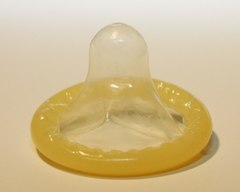Our website is made possible by displaying online advertisements to our visitors.
Please consider supporting us by disabling your ad blocker.
Condom
| Condom | |
|---|---|
 A rolled-up condom | |
| Background | |
| Pronunciation | /ˈkɒndəm/ KON-dəm or UK: /ˈkɒndɒm/ KON-dom |
| Type | Barrier |
| First use | Ancient[1] Rubber: 1855[2] Latex: 1920s[3] Polyurethane: 1994 Polyisoprene: 2008 |
| Pregnancy rates (first year, latex) | |
| Perfect use | 2%[4] |
| Typical use | 18%[4] |
| Usage | |
| Reversibility | Yes |
| User reminders | Latex condoms are damaged by oil-based lubricants[1] |
| Advantages and disadvantages | |
| STI protection | Yes[1] |
| Benefits | No health care visits required and low cost[1] |
A condom is a sheath-shaped barrier device used during sexual intercourse to reduce the probability of pregnancy or a sexually transmitted infection (STI).[1][5] There are both external condoms, also called male condoms, and internal (female) condoms.[6][7]
The external condom is rolled onto an erect penis before intercourse and works by forming a physical barrier which limits skin-to-skin contact, exposure to fluids, and blocks semen from entering the body of a sexual partner.[1][8] External condoms are typically made from latex and, less commonly, from polyurethane, polyisoprene, or lamb intestine.[1] External condoms have the advantages of ease of use, ease of access, and few side effects.[1] Individuals with latex allergy should use condoms made from a material other than latex, such as polyurethane.[1] Internal condoms are typically made from polyurethane and may be used multiple times.[8]
With proper use—and use at every act of intercourse—women whose partners use external condoms experience a 2% per-year pregnancy rate.[1] With typical use, the rate of pregnancy is 18% per-year.[4] Their use greatly decreases the risk of gonorrhea, chlamydia, trichomoniasis, hepatitis B, and HIV/AIDS.[1] To a lesser extent, they also protect against genital herpes, human papillomavirus (HPV), and syphilis.[1]
Condoms as a method of preventing STIs have been used since at least 1564.[1] Rubber condoms became available in 1855, followed by latex condoms in the 1920s.[2][3] It is on the World Health Organization's List of Essential Medicines.[9] As of 2019, globally around 21% of those using birth control use the condom, making it the second-most common method after female sterilization (24%).[10] Rates of condom use are highest in East and Southeast Asia, Europe and North America.[10]
- ^ a b c d e f g h i j k l m Hatcher RA, MD AL (2007). Contraceptive Technology. Ardent Media. pp. 297–311. ISBN 978-1-59708-001-9. Archived from the original on 18 September 2017.
- ^ a b Allen MJ (2011). The Anthem Anthology of Victorian Sonnets. Anthem Press. p. 51. ISBN 978-1-84331-848-4.
- ^ a b McKibbin R (2000). Classes and Cultures: England 1918–1951. Oxford University Press. p. 305. ISBN 978-0-19-820855-6.
- ^ a b c Trussell J (2011). "Contraceptive efficacy" (PDF). In Hatcher RA, Trussell J, Nelson AL, Cates W Jr, Kowal D, Policar MS (eds.). Contraceptive technology (20th revised ed.). New York: Ardent Media. pp. 779–863. ISBN 978-1-59708-004-0. ISSN 0091-9721. OCLC 781956734. Archived from the original (PDF) on 12 November 2013.
- ^ Weinstock SA, Lesser ML, Kassman LB (2006). "Condom—The need for predictable contraception". Sexuality, Reproduction and Menopause. 4 (2): 96–99. doi:10.1016/j.sram.2006.08.010.
- ^ World Health Organization (2009). Stuart MC, Kouimtzi M, Hill SR (eds.). WHO Model Formulary 2008. World Health Organization. p. 372. hdl:10665/44053. ISBN 978-92-4-154765-9.
- ^ Beksinska M, Wong R, Smit J (2020). "Male and female condoms: Their key role in pregnancy and STI/HIV prevention". Best Practice & Research Clinical Obstetrics & Gynaecology. 66: 55–67. doi:10.1016/j.bpobgyn.2019.12.001. PMID 32007451.
- ^ a b Speroff L, Darney PD (2011). A Clinical Guide for Contraception. Lippincott Williams & Wilkins. pp. 305–307. ISBN 978-1-60831-610-6. Archived from the original on 14 November 2016.
- ^ World Health Organization (2023). The selection and use of essential medicines 2023: web annex A: World Health Organization model list of essential medicines: 23rd list (2023). Geneva: World Health Organization. hdl:10665/371090. WHO/MHP/HPS/EML/2023.02.
- ^ a b "Contraceptive Use by Method: data booklet" (PDF). United Nations Department of Economic and Social Affairs. 2019. Archived (PDF) from the original on 13 December 2020. Retrieved 2 January 2021.
Previous Page Next Page


